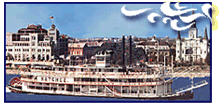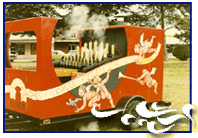 |
 |
 |
|
|||
|
Makin' Music on the Mighty Mississippi A paddlewheel churns up murky water as it propels the steamboat Natchez along the Mississippi River south of New Orleans, passing old factories, rusty barges, and Civil War battlefields. The Natchez is an old-fashioned, steam-driven paddle wheeler. On its top deck, beneath tall smokestacks and waving flags, sits its calliope. This shiny instrument from a bygone era resembles a pipe organ with 32 brass whistles. 
At the calliope's keyboard is "Doc" Hawley, who is also the captain of the S.S. Natchez. Hawley is an affable figure dressed in a crisp navy blue uniform and white cap. Since the Natchez's steam engine powers its calliope, clouds of mist shoot up from its whistles as Hawley plays.
Doc Hawley, who is in his sixties, got his start on the river by playing a calliope when he was only fifteen. One afternoon in 1950, a steamboat named the Avalon docked at his hometown of Charleston, West Virginia. Its calliope player had quit a week before, so Hawley, a pianist, mustered the courage to ask for an audition.

During their heyday, from 1811 until the early 1900s, thousands of steam paddle wheelers ferried passengers and cargo along the Mississippi. Many carried a calliope, which takes its name from the Greek muse of epic poetry. This loud instrument was popularized in circuses by showman P.T. Barnum. And its songs once heralded the arrival steamboats at towns up and down the Mississippi.
Today, only a handful of steamboats still navigate the swift currents of the mighty Miss. For a modest fee, visitors to the Crescent City can hear the nostalgic sounds of the calliope on daily cruises aboard the steamboat Natchez, which leaves from the city dock near the French Quarter. In New Orleans, I'm Lex Gillespie for the Savvy Traveler.
|
 | American Public Media Home | Search | How to Listen ©2004 American Public Media | Terms of Use | Privacy Policy |
